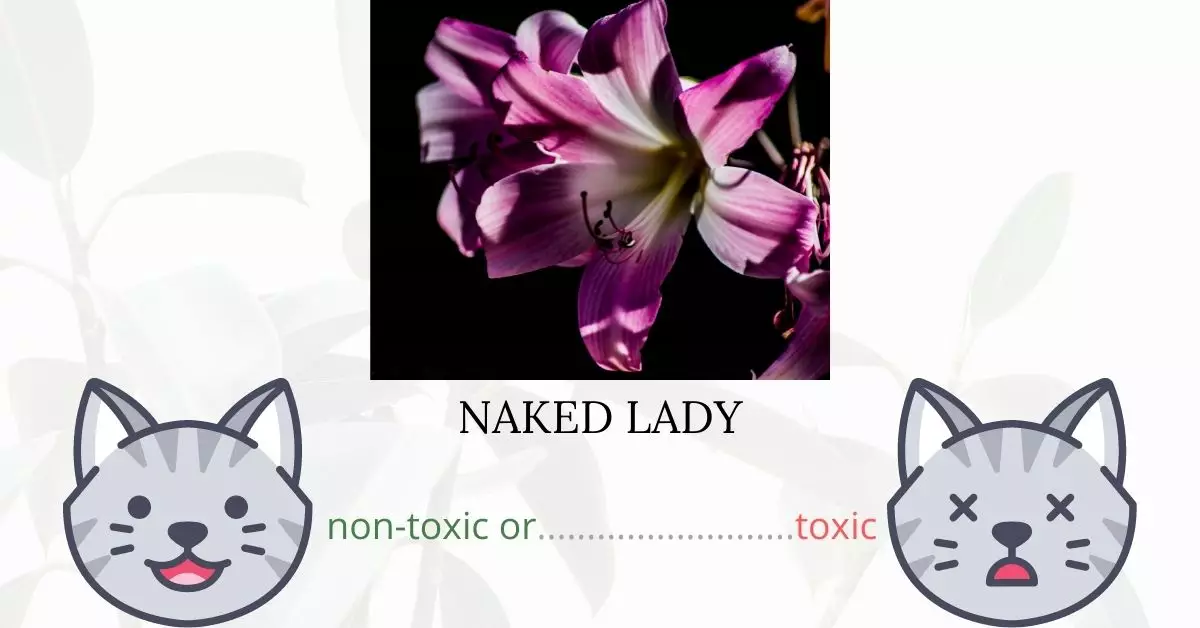The Naked Lady plant, renowned for its captivating blossoms, is a common addition to many gardens, enhancing them with its vibrant beauty. However, cat owners must be discerning and considerate, as this enchanting flora harbors toxins detrimental to cats. The Naked Lady plant is indeed toxic to cats.
This article is a culmination of meticulous research and collaboration with a team of seasoned Doctors of Veterinary Medicine (DVMs), whose invaluable insights have been instrumental in detailing the precise risks associated with the Naked Lady plant and its effects on cats. Through their extensive knowledge and experience, we aim to disseminate accurate and current information on the potential hazards that various plants, especially the Naked Lady, pose to feline companions. Additionally, our analysis incorporates information sourced from reputable and authoritative websites such as the ASPCA and PetMD to ensure comprehensive coverage of each plant discussed.
The primary toxin found in the Naked Lady plant, lycorine, is capable of eliciting a spectrum of symptoms, spanning from gastrointestinal upset to serious central nervous system complications, with the plant’s blossoms containing the highest concentration of this toxin. While initially, the manifestations may appear mild, exposure to the Naked Lady plant can potentially inflict severe and lasting damage to a cat’s central nervous system.
Clinical Signs of Naked Lady Poisoning in Cats
The interaction of cats with the Naked Lady plant, whether through contact, inhalation, or ingestion, can precipitate an array of clinical symptoms due to its inherent toxin, lycorine. It is crucial for cat owners to recognize and understand each sign as the onset is typically swift, reducing the likelihood of cats consuming large amounts. Immediate veterinary attention is imperative if your cat exhibits any of the following symptoms, even if the ingestion is suspected to be minimal, particularly of the bulbs where the toxin concentration is substantial.
- Vomiting: A common immediate reaction due to the body’s attempt to rid itself of the ingested toxin, purging the harmful substance from the system.
- Diarrhea: The toxin disrupts normal gastrointestinal function, leading to rapid bowel movements as the body tries to expel it.
- Drooling: The plant’s toxin can cause irritation and excessive salivation as the body’s response to exposure.
- Loss of Appetite: The toxic effects on the gastrointestinal system often cause a decline in the desire to eat due to discomfort and nausea.
- Lethargy: The cat’s energy levels plummet due to the systemic impact of the toxin, leading to overall weakness and fatigue.
- Shaking: Neurological impairment caused by lycorine can lead to involuntary muscle contractions and tremors.
- Discolored Urine: The body’s detoxification process might alter urine color due to the presence of toxins or as a sign of kidney involvement.
- Oral or Skin Irritation: Direct contact with the toxin can result in inflammation and irritation of the skin or oral mucosa.
- Paralysis: Severe cases can witness a compromise in neuromuscular function, leading to partial or complete loss of muscle function.
- High Blood Pressure: The toxin’s impact on the cardiovascular system can induce elevated blood pressure, posing additional risks.
- Irregular Heartbeat: Lycorine can disrupt normal cardiac rhythms, leading to potentially life-threatening arrhythmias.
- Convulsions: Extreme neurological interference from the toxin can manifest as sudden, violent muscle contractions or seizures.
- Sudden Death: In extreme cases, the rapid onset and the cumulative effect of these symptoms can lead to sudden, unforeseen fatality.
Each of these clinical signs is indicative of severe distress, and immediate veterinary intervention is crucial to mitigate the effects of the toxin and to administer appropriate treatment measures promptly.
First Aid and Treatment of Naked Lady Poisoning in Cats
In severe cases of poisoning, your veterinarian will not induce vomiting because it may worsen the symptoms. Your veterinarian may recommend gastric lavage, which includes flushing your cat’s stomach with water or a saline solution. If organ damage has occurred, your cat may need to be admitted so that the vet can keep an eye on its organ function.
Other treatments, such as hydration therapy, the administration of activated charcoal, and the administration of other drugs to ease symptoms, may be performed by the veterinarian depending on the circumstances.
Recovery from Naked Lady Poisoning in Cats
The outcome for modest cases of naked lady poisoning that are treated swiftly and effectively is usually favorable. Mild plant poisoning in cats normally clears itself within 24 hours. For severe cases, the prognosis is often uncertain, and your vet will most likely schedule follow-up sessions as needed to evaluate the cat’s organ function.
Prevention of Naked Lady Poisoning in Cats
Avoid growing naked lady plants or any other toxic plants as they may cause harm to your feline companions. Be cautious of bringing in any plants in your house. Restrict your cat from going too much outside to prevent exposure to toxic plants that are growing in your area.
If you love plants but have cats at home, check out these lists:





